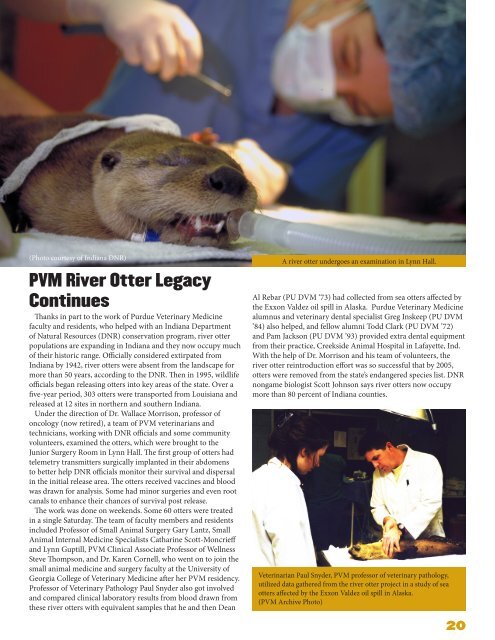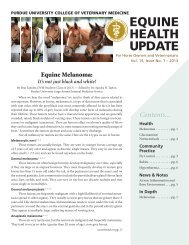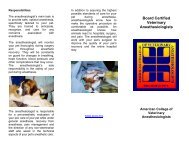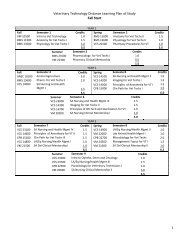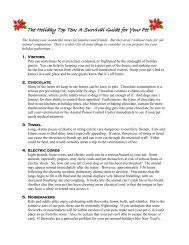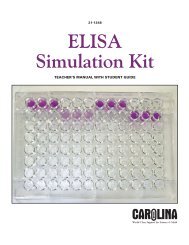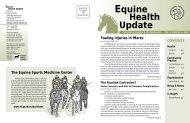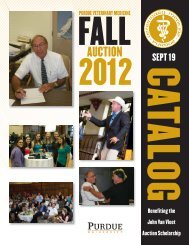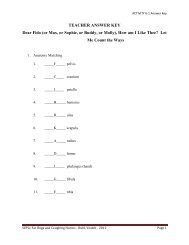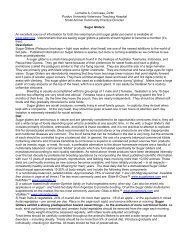2013 PVM Report - Purdue University School of Veterinary Medicine
2013 PVM Report - Purdue University School of Veterinary Medicine
2013 PVM Report - Purdue University School of Veterinary Medicine
You also want an ePaper? Increase the reach of your titles
YUMPU automatically turns print PDFs into web optimized ePapers that Google loves.
(Photo courtesy <strong>of</strong> Indiana DNR)<br />
<strong>PVM</strong> River Otter Legacy<br />
Continues<br />
Thanks in part to the work <strong>of</strong> <strong>Purdue</strong> <strong>Veterinary</strong> <strong>Medicine</strong><br />
faculty and residents, who helped with an Indiana Department<br />
<strong>of</strong> Natural Resources (DNR) conservation program, river otter<br />
populations are expanding in Indiana and they now occupy much<br />
<strong>of</strong> their historic range. Officially considered extirpated from<br />
Indiana by 1942, river otters were absent from the landscape for<br />
more than 50 years, according to the DNR. Then in 1995, wildlife<br />
<strong>of</strong>ficials began releasing otters into key areas <strong>of</strong> the state. Over a<br />
five-year period, 303 otters were transported from Louisiana and<br />
released at 12 sites in northern and southern Indiana.<br />
Under the direction <strong>of</strong> Dr. Wallace Morrison, pr<strong>of</strong>essor <strong>of</strong><br />
oncology (now retired), a team <strong>of</strong> <strong>PVM</strong> veterinarians and<br />
technicians, working with DNR <strong>of</strong>ficials and some community<br />
volunteers, examined the otters, which were brought to the<br />
Junior Surgery Room in Lynn Hall. The first group <strong>of</strong> otters had<br />
telemetry transmitters surgically implanted in their abdomens<br />
to better help DNR <strong>of</strong>ficials monitor their survival and dispersal<br />
in the initial release area. The otters received vaccines and blood<br />
was drawn for analysis. Some had minor surgeries and even root<br />
canals to enhance their chances <strong>of</strong> survival post release.<br />
The work was done on weekends. Some 60 otters were treated<br />
in a single Saturday. The team <strong>of</strong> faculty members and residents<br />
included Pr<strong>of</strong>essor <strong>of</strong> Small Animal Surgery Gary Lantz, Small<br />
Animal Internal <strong>Medicine</strong> Specialists Catharine Scott-Moncrieff<br />
and Lynn Guptill, <strong>PVM</strong> Clinical Associate Pr<strong>of</strong>essor <strong>of</strong> Wellness<br />
Steve Thompson, and Dr. Karen Cornell, who went on to join the<br />
small animal medicine and surgery faculty at the <strong>University</strong> <strong>of</strong><br />
Georgia College <strong>of</strong> <strong>Veterinary</strong> <strong>Medicine</strong> after her <strong>PVM</strong> residency.<br />
Pr<strong>of</strong>essor <strong>of</strong> <strong>Veterinary</strong> Pathology Paul Snyder also got involved<br />
and compared clinical laboratory results from blood drawn from<br />
these river otters with equivalent samples that he and then Dean<br />
A river otter undergoes an examination in Lynn Hall.<br />
Al Rebar (PU DVM ‘73) had collected from sea otters affected by<br />
the Exxon Valdez oil spill in Alaska. <strong>Purdue</strong> <strong>Veterinary</strong> <strong>Medicine</strong><br />
alumnus and veterinary dental specialist Greg Inskeep (PU DVM<br />
’84) also helped, and fellow alumni Todd Clark (PU DVM ’72)<br />
and Pam Jackson (PU DVM ’93) provided extra dental equipment<br />
from their practice, Creekside Animal Hospital in Lafayette, Ind.<br />
With the help <strong>of</strong> Dr. Morrison and his team <strong>of</strong> volunteers, the<br />
river otter reintroduction effort was so successful that by 2005,<br />
otters were removed from the state’s endangered species list. DNR<br />
nongame biologist Scott Johnson says river otters now occupy<br />
more than 80 percent <strong>of</strong> Indiana counties.<br />
Veterinarian Paul Snyder, <strong>PVM</strong> pr<strong>of</strong>essor <strong>of</strong> veterinary pathology,<br />
utilized data gathered from the river otter project in a study <strong>of</strong> sea<br />
otters affected by the Exxon Valdez oil spill in Alaska.<br />
(<strong>PVM</strong> Archive Photo)<br />
20


